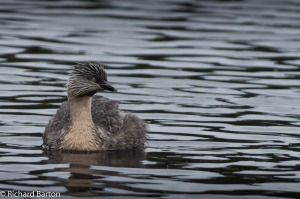A fine sunny morning greeted the 27 participants who arrived at the Stringybark Picnic area in the Cranbourne Botanical Gardens on the 18th October. Regretfully, a high cloud cover arrived as the day progressed reducing some of the photographic opportunities.
However, the day started in a promising fashion as one of the first areas visited was an open paddock adjacent to the gardens to see if the Black-shouldered Kite that inhabits the area could be seen. It was almost immediately sighted over the paddock and then obliged by flying into the gardens and roosting on a dead tree to consume the prey (appeared to be a rat) it had just caught. Despite the bank of cameras pointed at the Black-shouldered Kite it patiently devoured the prey providing ample opportunity for photographs.
Continuing our walk around the southern side of the gardens, a nesting Tawny Frogmouth was discovered on a branch about four metres above the ground. For a frogmouth, it seemed to have a reasonable nest of twigs upon which it was sitting. Again, plenty of photographic opportunities.
Tawny Frogmouth – John Bosworth
Continuing on to the nearby ponds several water birds were sighted including Blue-billed Duck (the male’s bill was strikingly blue), White-necked Heron, Hoary-headed Grebe, Hardhead and Grey Teal. We then journeyed into the bushland where cuckoos were the order of the day with the Fan-tailed being constantly heard but not sighted, the Pallid Cuckoo was also heard but eventually came into view together with the Horsefield’s and the Shining Bronze-Cuckoo.
Pacific Black Duck and White-necked Heron – Michael Gage
Honeyeaters were represented by the White-eared, Yellow-faced, White-plumed as well as the inevitable Red Wattlebird. Smaller bush birds included Striated and Spotted Pardalote, Brown Thornbill, White-browed Scrubwren and the ubiquitous Superb Fairy-wren. In addition to the Black-shouldered Kite, the other raptors positively identified were Wedged-tailed Eagle and Swamp Harrier.
We returned to the Stringybark Picnic area for lunch where the Southern Brown Bandicoot is often seen, however, only one was noticed beating a hasty retreat into the bush with only a limited number of people seeing it.
After lunch most of the group travelled to the more formal Australian Garden. We started with a short walk up to the trig point which provided splendid views of the surrounding country-side but not very many birds. The remainder of the afternoon was spent walking through the Australian Garden with its proliferation of New Holland Honeyeaters, while other sightings added to the list included Dusky Woodswallow, Masked Lapwing, Australasian Grebe, European Goldfinch and Willie Wagtail.
Snakes have been prevalent in the gardens in recent weeks and the management had placed additional signage to warn of the dangers. Two tiger snakes were sighted – and photographed – in the formal gardens which is quite a problem considering the large number of visitors to this area.
Like all good bird outings we managed to do bird call (62 species) within the proverbial stone’s throw of the Gardens café where most participants adjourned to before travelling home.
John Bosworth








